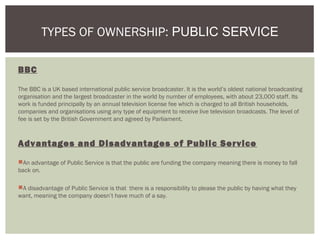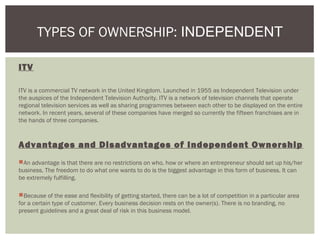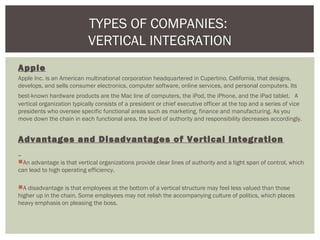Media Ownership
- 1. Task 1 Understand the structure and ownership of the media sector. P1, M1, D1 EXPLAINING THE STRUCTURE AND OWNERSHIP OF THE MEDIA SECTOR
- 2. Sky Sky was founded in November 1990and was founded by Rupert Murdoch. Sky is a British satellite broadcasting, broadband and telephone services headquartered in London. Sky is the largest pay-tv broadcaster in the UK and Ireland with over 10 million subscribers. It had a market capitalisation of approximately £13.69 billion as of 14 August 2014. Advantages and Disadvantages of Private Ownership An advantage of Private Ownership is that because the company is owned by you entirely, you receive all the money that is earned. A disadvantage of Private Ownership is that it isn’t better funded as a company funded by Public Service, as Private Ownership doesn’t receive money from the public. TYPES OF OWNERSHIP: PRIVATE OWNERSHIP
- 3. BBC The BBC is a UK based international public service broadcaster. It is the world’s oldest national broadcasting organisation and the largest broadcaster in the world by number of employees, with about 23,000 staff. Its work is funded principally by an annual television license fee which is charged to all British households, companies and organisations using any type of equipment to receive live television broadcasts. The level of fee is set by the British Government and agreed by Parliament. Advantages and Disadvantages of Public Service An advantage of Public Service is that the public are funding the company meaning there is money to fall back on. A disadvantage of Public Service is that there is a responsibility to please the public by having what they want, meaning the company doesn’t have much of a say. TYPES OF OWNERSHIP: PUBLIC SERVICE
- 4. Disney The Walt Disney Company is an American diversified multinational mass media corporation headquartered at the Walt Disney Studios in Burbank, California. It is the world’s second largest broadcasting and cable company in terms of revenue, after Comcast. Disney was founded on October 16, 1923. Advantages and Disadvantages of Multinational Ownership An advantage is that they increase the investment level and also the income and employment in the host country. A disadvantage is that taxes or tariffs imposed on imports from other countries. TYPES OF OWNERSHIP: MULTINATIONAL
- 5. ITV ITV is a commercial TV network in the United Kingdom. Launched in 1955 as Independent Television under the auspices of the Independent Television Authority. ITV is a network of television channels that operate regional television services as well as sharing programmes between each other to be displayed on the entire network. In recent years, several of these companies have merged so currently the fifteen franchises are in the hands of three companies. Advantages and Disadvantages of Independent Ownership An advantage is that there are no restrictions on who, how or where an entrepreneur should set up his/her business. The freedom to do what one wants to do is the biggest advantage in this form of business. It can be extremely fulfilling. Because of the ease and flexibility of getting started, there can be a lot of competition in a particular area for a certain type of customer. Every business decision rests on the owner(s). There is no branding, no present guidelines and a great deal of risk in this business model. TYPES OF OWNERSHIP: INDEPENDENT
- 6. BBC A media conglomerate, media group or media institution is a company that owns large numbers of companies in various mass media such as television, radio, publishing, movies, and the Internet. An example of a Conglomerate is the BBC. Advantages and Disadvantages of Conglomerate Ownership An advantage is that a conglomerate creates an internal capital market if the external one is not developed enough. Through the internal market, different parts of conglomerate allocate capital more effectively. A disadvantage is that there can be a lack of focus, and inability to manage unrelated businesses equally well. TYPES OF OWNERSHIP: CONGLOMERATE
- 7. X Factor The X Factor is a British television music competition to find new singing talent, contested by aspiring singers drawn from public auditions. Created by Simon Cowell, the show began in 2004 and has since aired annually from August/September until December. In business, horizontal integration is a strategy where a company creates or acquires production units for outputs which are alike - either complementary or competitive. Advantages and Disadvantages of Horizontal Integration An advantages is that employees may attain greater satisfaction in a horizontal structure due to greater freedom and autonomy. A disadvantages is that the decentralized structure could lead to a "loose ship," as the team and project leaders have high levels of responsibility for achieving results but little real authority over their team members. TYPES OF COMPANIES: HORIZONTAL INTEGRATION
- 8. Apple Apple Inc. is an American multinational corporation headquartered in Cupertino, California, that designs, develops, and sells consumer electronics, computer software, online services, and personal computers. Its best-known hardware products are the Mac line of computers, the iPod, the iPhone, and the iPad tablet. A vertical organization typically consists of a president or chief executive officer at the top and a series of vice presidents who oversee specific functional areas such as marketing, finance and manufacturing. As you move down the chain in each functional area, the level of authority and responsibility decreases accordingly. Advantages and Disadvantages of Vertical Integration An advantage is that vertical organizations provide clear lines of authority and a tight span of control, which can lead to high operating efficiency. A disadvantage is that employees at the bottom of a vertical structure may feel less valued than those higher up in the chain. Some employees may not relish the accompanying culture of politics, which places heavy emphasis on pleasing the boss. TYPES OF COMPANIES: VERTICAL INTEGRATION
- 9. commonly defined as a drawing apart, as of lines extending from a common centre, the acquisition of dissimilar characteristics by related organisms in unlike environments and a deviation from a course or a standard. Similarly to the concept of convergence, divergence is frequently used within several academic fields such as mathematics, optics, and biology. CROSS MEDIA DIVERGENCE
- 10. Is the term used to describe a situation where different entities cooperate advantageously for a final outcome. Simply defined, it means that the whole is greater than the sum of its parts. In media economics, synergy is the promotion and sale of a product (and all its versions) throughout the various subsidiaries of a media conglomerate e.g. films, soundtracks or video games. SYNERGY
- 11. If looking at the film industry compare the American and UK industry. Explain what types of companies they are (horizontal or vertical) Explain the benefits / weaknesses of this If looking at the music industry look at companies from the “big three” to an independent as well as subsidiaries. Look at who is involved and how it is structured This site might help… http:// www.planetoftunes.com/industry/industry_structure.htm Aim to do 500 words DESCRIBE THE STRUCTURE AND OF OWNERSHIP OF EITHER THE FILM INDUSTRY OR MUSIC INDUSTRY










